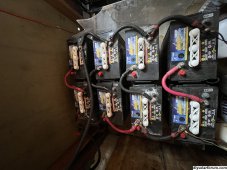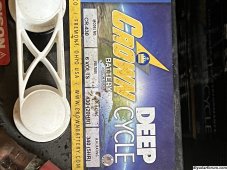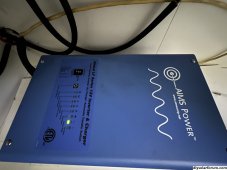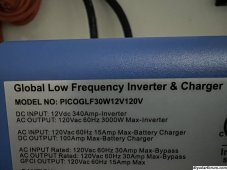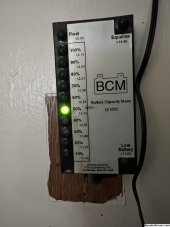Hello I am in need of some help . I bought this cabin that they are using an xantrex dr2412 invertor charger with older pannels 4 @ 100 watts each to a battery bank of 8 crown deep cycle 6volts wire to 12v . well the invertor went out so I bought a 3000w from aims power and hooked it up. Well now it seems that rather my pannels or batteries are not doing well and I’m not sure we’re to go from here. It will not fully charge to 100% an one of the Solar pannels is all black . The system is over 20 years old . Any recommendations on pannels an batteries ? Should I add pannels first an go from there ? The batteries do not look that old an were barely used.? Need all the help I can get lol . Will send pics if needed .
You are using an out of date browser. It may not display this or other websites correctly.
You should upgrade or use an alternative browser.
You should upgrade or use an alternative browser.
Expert Need for Off Grid System
- Thread starter Gauge
- Start date
The first thing I would buy is a meter to check the voltages at each battery and panel and to measure the current each panel can provide.
See what state things are in first. Perhaps a hydrometer for checking SG on each cell in each battery after you try charging them each individually with an AC powered charger (or 2 in series ) from a vehicle alternator. With 4 parallel strings it is difficult to get the batteries to share the load evenly.
You have enough batteries that if they were wired in series you'd have a 48v system. Think about what your goals and your budget are before you start spending money.
12V 100 watt panels are relatively expensive for what they are. A larger 250 watt 60 cell or 72 cell solar panel (new or used) can give you more power per $ ... at the expense of needing a MPPT charge controller to take advantage of the higher voltage the panel produces.
A single 72 cell panel could produce as much or more power than your existing array, a MPPT charge controller could work at 12, 24, 48v etc
At 12V a 30 amp charge controller could support a single 400 watt panel (or 4 100 watt panels for that matter) at 48 v it could support 4 times that.
The array should be matched to the capacity of the battery, the inverter should be sized as small as practical to minimize standby losses and will limit how quickly you can discharge your battery. The inverter should be sized large enough to run the largest item you want to run ... now do the math of how long the battery bank will support that load.
400 watts at 12v is around 33 amps. Best case solar. Your 3000 watt inverter may draw closer to 300 amps. It would take days to replace the energy the inverter could use 8n a few hrs.
A smaller inverter would be a better match for the rest of the system. Consider a small generator for larger loads and battery charging.
See what state things are in first. Perhaps a hydrometer for checking SG on each cell in each battery after you try charging them each individually with an AC powered charger (or 2 in series ) from a vehicle alternator. With 4 parallel strings it is difficult to get the batteries to share the load evenly.
You have enough batteries that if they were wired in series you'd have a 48v system. Think about what your goals and your budget are before you start spending money.
12V 100 watt panels are relatively expensive for what they are. A larger 250 watt 60 cell or 72 cell solar panel (new or used) can give you more power per $ ... at the expense of needing a MPPT charge controller to take advantage of the higher voltage the panel produces.
A single 72 cell panel could produce as much or more power than your existing array, a MPPT charge controller could work at 12, 24, 48v etc
At 12V a 30 amp charge controller could support a single 400 watt panel (or 4 100 watt panels for that matter) at 48 v it could support 4 times that.
The array should be matched to the capacity of the battery, the inverter should be sized as small as practical to minimize standby losses and will limit how quickly you can discharge your battery. The inverter should be sized large enough to run the largest item you want to run ... now do the math of how long the battery bank will support that load.
400 watts at 12v is around 33 amps. Best case solar. Your 3000 watt inverter may draw closer to 300 amps. It would take days to replace the energy the inverter could use 8n a few hrs.
A smaller inverter would be a better match for the rest of the system. Consider a small generator for larger loads and battery charging.
Okay, maybe you can answer this to get more help: How old are your batteries? What is the rated amps capacity of your model batteries? There should be like a C20 rating (how much power put out when over a level 20 hour period of use)? Have you removed the caps of each cell and determined that the electrolyte level is a proper capacity? Obtain a specific gravity battery tester (auto parts store or amazon) and measure for each cell. Use a quality volt meter on each cell. Max about 2.25 volts or a little higher would be close to fully charged. Make certain any cables attached to batteries and to inverter or charger are tight and free of corrosion. Make certain inverter charger or charge controller properly configured for your model battery. Manufacturer should supply charging parameters of voltages and times as well as equalization parameters. Please report back and can advise further on path forward.
Bluedog225
Texas
- Joined
- Nov 18, 2019
- Messages
- 2,917
Stop buying stuff till you have a plan. You will save a bunch. And read here for a month.
And welcome.
And welcome.
All good advice so far, esp. do not buy anything until you've assessed what you have and have a plan for your requirements.
Even 2 year old lead acid batteries can be ruined with poor care. Alternatively, some users get 10 or more productive years out of lead-acid batteries so you need to know the age and condition of your batteries.
Lead-acid batteries require consistent care and maintenance to keep them near their spec'd storage capacity. Crown should have a detailed manual on the maintenance requirements for your batteries although I'm not seeing one on their site (https://www.crownbattery.com/resources). You're looking for something like this (https://assets.ctfassets.net/nh2mdh...23005-Users-Guide-FLOODED-AES-AGM-GEL-WEB.pdf) that is provided by Trojan for their batteries. General guidelines for lead-acid will work but the mfr. specs are best. I've learned a lot from sections 5 - 9 (charging, storage, maximizing performance and troubleshooting) in that Trojan manual
If your batteries are NOT Crown SEALED deep cycle batteries, ensure that each cell has enough electrolyte in it then charge the batteries and measure the specific gravity.
Things for you to know in order to maintain your batteries:
- Max charge current
- Absorption voltage
- Absorption time
- Equalization time (only if your batteries are NOT sealed)
Here's what the chart from Trojan looks like. There's also a chart for SG specs:

Also, I see that you're in Idaho, if you're north, check out Backwoods Solar (https://backwoodssolar.com/) and order their catalog (yes, they've been in the biz for 40 years and still produce a catalog!) - it's chock full of helpful information and the people on the phone are very helpful. If you're able to visit the shop, sit around the kitchen table, ask questions and they'll help you design a system.
Even 2 year old lead acid batteries can be ruined with poor care. Alternatively, some users get 10 or more productive years out of lead-acid batteries so you need to know the age and condition of your batteries.
Lead-acid batteries require consistent care and maintenance to keep them near their spec'd storage capacity. Crown should have a detailed manual on the maintenance requirements for your batteries although I'm not seeing one on their site (https://www.crownbattery.com/resources). You're looking for something like this (https://assets.ctfassets.net/nh2mdh...23005-Users-Guide-FLOODED-AES-AGM-GEL-WEB.pdf) that is provided by Trojan for their batteries. General guidelines for lead-acid will work but the mfr. specs are best. I've learned a lot from sections 5 - 9 (charging, storage, maximizing performance and troubleshooting) in that Trojan manual
If your batteries are NOT Crown SEALED deep cycle batteries, ensure that each cell has enough electrolyte in it then charge the batteries and measure the specific gravity.
Things for you to know in order to maintain your batteries:
- Max charge current
- Absorption voltage
- Absorption time
- Equalization time (only if your batteries are NOT sealed)
Here's what the chart from Trojan looks like. There's also a chart for SG specs:

Also, I see that you're in Idaho, if you're north, check out Backwoods Solar (https://backwoodssolar.com/) and order their catalog (yes, they've been in the biz for 40 years and still produce a catalog!) - it's chock full of helpful information and the people on the phone are very helpful. If you're able to visit the shop, sit around the kitchen table, ask questions and they'll help you design a system.
Thank u so muchAll good advice so far, esp. do not buy anything until you've assessed what you have and have a plan for your requirements.
Even 2 year old lead acid batteries can be ruined with poor care. Alternatively, some users get 10 or more productive years out of lead-acid batteries so you need to know the age and condition of your batteries.
Lead-acid batteries require consistent care and maintenance to keep them near their spec'd storage capacity. Crown should have a detailed manual on the maintenance requirements for your batteries although I'm not seeing one on their site (https://www.crownbattery.com/resources). You're looking for something like this (https://assets.ctfassets.net/nh2mdh...23005-Users-Guide-FLOODED-AES-AGM-GEL-WEB.pdf) that is provided by Trojan for their batteries. General guidelines for lead-acid will work but the mfr. specs are best. I've learned a lot from sections 5 - 9 (charging, storage, maximizing performance and troubleshooting) in that Trojan manual
If your batteries are NOT Crown SEALED deep cycle batteries, ensure that each cell has enough electrolyte in it then charge the batteries and measure the specific gravity.
Things for you to know in order to maintain your batteries:
- Max charge current
- Absorption voltage
- Absorption time
- Equalization time (only if your batteries are NOT sealed)
Here's what the chart from Trojan looks like. There's also a chart for SG specs:
View attachment 167701
Also, I see that you're in Idaho, if you're north, check out Backwoods Solar (https://backwoodssolar.com/) and order their catalog (yes, they've been in the biz for 40 years and still produce a catalog!) - it's chock full of helpful information and the people on the phone are very helpful. If you're able to visit the shop, sit around the kitchen table, ask questions and they'll help you design a system.
Rednecktek
Solar Wizard
OK, first off that controller is NOT a real MPPT, it's a cheap PWM so you're not going to get nearly enough out of it. Get a proper MPPT controller, even a cheap one, at the very least. Depending on how your panels are wired you're seeing 300w at BEST with perfect sun at ideal conditions.
Second, lead acid batteries really REALLY HATE being undercharged for any length of time, which I'm guessing has been done since day 1. Be prepared for them to be a complete loss.
Third, look on your local Craigslist/Fakebook Marketplace/Etc for used household panels. You can get a 100w panel for about $100 on Amazon OR you can regularly find 250w panels for about $100 on Craigslist. Get a few of those and an MPPT controller and life will be amazingly happier.
Fourth, be aware that inverter is going to want to be able to draw 300-ish amps when fully ramped up. Those lead acids, even with 4x banks, is going to have a bit of a hard time with that. If/When you replace the batteries, since most off-the-shelf LFP batteries come with a 100a BMS involved, you'll want to plan for at least 3 batteries in parallel to feed it. Preferably 4 if you can swing it.
Test the input from your existing panels and see what you're getting. Test each panel individually if you can swing it. That'll let you know what you have to work with currently. Then go get a cheap MPPT controller (hell, even a PowMr will be a world of difference!) and reconfigure your panels to play better.
Let us know what your panels are producing and we can help guide you along to reviving this system for many years of bright light. ?
Second, lead acid batteries really REALLY HATE being undercharged for any length of time, which I'm guessing has been done since day 1. Be prepared for them to be a complete loss.
Third, look on your local Craigslist/Fakebook Marketplace/Etc for used household panels. You can get a 100w panel for about $100 on Amazon OR you can regularly find 250w panels for about $100 on Craigslist. Get a few of those and an MPPT controller and life will be amazingly happier.
Fourth, be aware that inverter is going to want to be able to draw 300-ish amps when fully ramped up. Those lead acids, even with 4x banks, is going to have a bit of a hard time with that. If/When you replace the batteries, since most off-the-shelf LFP batteries come with a 100a BMS involved, you'll want to plan for at least 3 batteries in parallel to feed it. Preferably 4 if you can swing it.
Test the input from your existing panels and see what you're getting. Test each panel individually if you can swing it. That'll let you know what you have to work with currently. Then go get a cheap MPPT controller (hell, even a PowMr will be a world of difference!) and reconfigure your panels to play better.
Let us know what your panels are producing and we can help guide you along to reviving this system for many years of bright light. ?
thanks so much for all your input , I did not have time but I am off the next few days an going to get to the bottom of this , an test everything. Any idea of controller I should get does anyone have a link ? An if these batteries are toast then what batteries should I buy, I’m primarily looking to run a fridge some lights an charge phones nothing major , I have everything else on propane, an when u mean test what’s coming in as far as volts or ? Is it ok to unhook these batteries or will I get shocked if I don’t follow a certain order ? Also it appears the pannels come from roof , I will send pics an there to this shunt it looks like then the other side of that goes to controller. Shouldn’t I have a fuse / breaker somewhere?
MisterSandals
Participation Medalist
You should do an energy audit to get an understanding of how much power you need from this system.Also any recommendations on a new small system that would run what I need an just start over new instead of wasting time with this ?
My gut feel is that your panels are woefully undersized and your charge controller is probably only capably of maintaining batteries and not supply much useful power. Your new inverter likely consumes most of what your solar produces just by idle power consumption (a few watts running 24/7 adds up quickly).
Its possible your batteries are usable for now.
With a power audit you can size a solar array necessary to harvest the energy you need. Sizing a charge controller is based on array and batteries.
Ok my fridge uses 497 kw a year an just basic lights , an your description was accurate because it seems as if it is just charging batteries an I can run a handful of lights but that’s it’s an it drains plus yes that aims inverter does draw as well.
Ok everyone I have been really sick but just was able to get out a test batteries with hydrometer an all 8 batteries are from 12.25 to 12.75 . Which seem to be ok? As I observe this more it really does seem that there is just not enough to fully charge them .. So should I just try to add some basic pannels to the batteries an see if that helps with a new controller? Any help
yodamota
Solar Enthusiast
did you write down what each battery is? if the cells vary from 1.225 - 1.275
ie carumba!
in regards to lead acid batteries. I use this manual for most reference
ie carumba!
in regards to lead acid batteries. I use this manual for most reference
MisterSandals
Participation Medalist
So should I just try to add some basic pannels to the batteries an see if that helps with a new controller? Any help
You should still do a basic energy audit. Without it, everything is a guess.Anyone ?
Someone pointed out that your SCC is a cheap PWM which might be fine for 4x 100W panels in parallel. It will not support any more panels.
Adding panels and a charge controller are probably the right thing to do. But this is just a guess operating with virtually no info.
Are there any big cheap solar panels in your area? We could find a suitable SCC to work with them but should verify the panels specs before purchasing.
Ok yes I’m still not quite sure of meaning of how to do an audit of someone could help me here.. yes all batteries were over 12.50 an two were 12.25. All I am using is fridge At 497kwh a year a random lights a charge phone. I bought a charge controller Mppt it’s showed no difference at all. So I just bought 6 pannels 100w each from HQST and I’m going to add this weekend to see what it does. Maybe I should charge them up with the generator then hook everything up?
MisterSandals
Participation Medalist
Its just adding up the power that you use, normally in a day.sure of meaning of how to do an audit
Make a list of your powered items. Determine how many watts they use. And estimate how many hours a day you use them.
TV: 240W x 6h = 1440Wh
Lights: 50W x 10h = 500Wh
Microwave: 1200W x .25h = 300Wh
(fridge At 497kwh a year / 365 days = 1360Wh)
....
This (incomplete) example is a total of 3600Wh per day
With this, we can determine how much solar we need to produce this:
(idaho maybe 5h solar summer, 2h winter?)
3600Wh / 5h summer solar = 720W of solar (at theoretical 100%, 1000-1200W realistic)
3600Wh / 2h winter solar = 1800W of solar (maybe 2500W or more of solar to be realistic)
Similar threads
- Replies
- 13
- Views
- 659
- Replies
- 96
- Views
- 2K
- Replies
- 22
- Views
- 963
- Replies
- 4
- Views
- 481
- Replies
- 20
- Views
- 857



